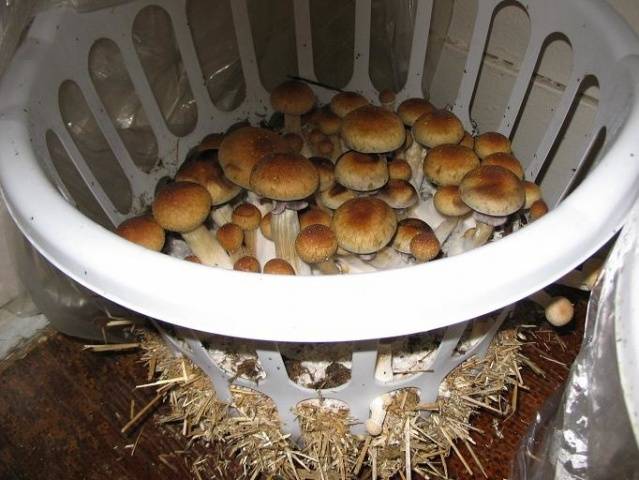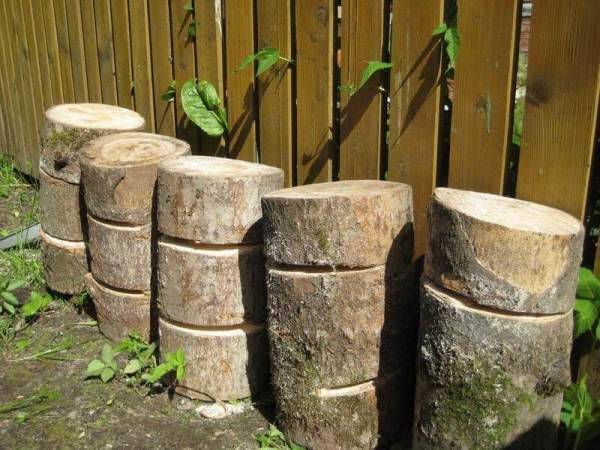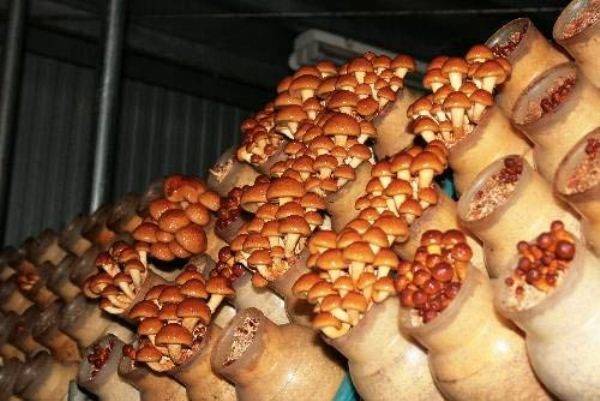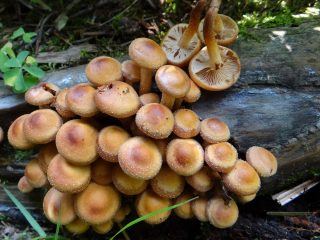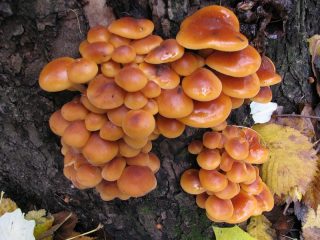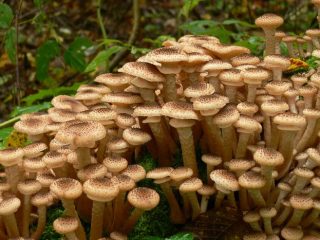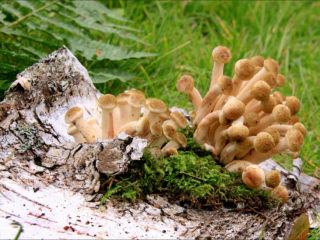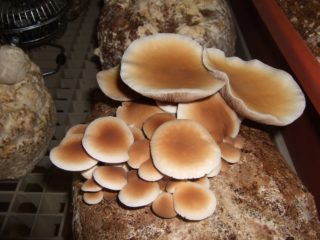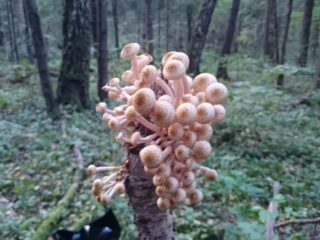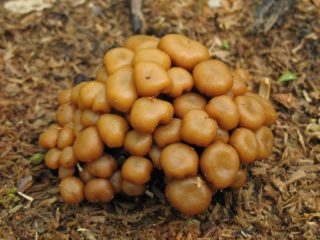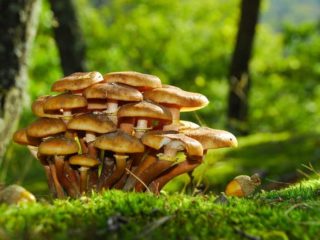Content
- 1 Common ways to harvest honey mushrooms at home
- 2 Technology for self-production of mycelium
- 3 Optimal conditions for growing honey mushrooms
- 4 Growing honey mushrooms in a damp basement or cellar
- 5 Three ways to harvest honey mushrooms on logs
- 6 The greenhouse is the best place for honey mushrooms
- 7 Growing in glass jars
- 8 Breeding honey mushrooms on a growing stump
Among edible mushrooms, honey mushrooms stand out for their good taste, forest aroma, and rapid growth. If desired, they can be grown on your own plot from purchased mycelium or mycelium found in a forest clearing. In addition to getting a harvest, mushroom growing is a very exciting business. It is possible to grow honey mushrooms at home for beginners; the main thing is to follow the technology of the process.
Common ways to harvest honey mushrooms at home
Mushrooms take root so easily that even beginners can grow honey mushrooms in the country and in the garden. The main requirement is to maintain high humidity and constant temperature.
The most common growing methods are:
- on logs or stumps;
- in the basement using bags;
- in a greenhouse;
- in a glass jar.
Beginners are often interested in the question of how to grow honey mushrooms in the country on stumps, since this method is considered less expensive. You just need to buy mycelium. Stumps are used growing from old trees or pieces of cut logs.The mycelium is colonized inside the drilled holes, after which they are covered with moss or damp sawdust.
If honey mushrooms are grown in the country on cut logs, then a damp place is found for them, preferably basement, where the temperature is maintained at about 20OC. Before the mycelium germinates, they are covered with straw and constantly moistened, then taken outside and buried in the ground.
Residents of an apartment are suitable for growing honey mushrooms in jars with a capacity of 1–3 liters. The essence of the method is to prepare a nutrient substrate, the basis of which is sawdust or husks from sunflower seeds. After sowing the mycelium, the jars are stored at a temperature of about +24OC, then transferred to a cool place.
If there is an empty basement or greenhouse at the dacha, then this will be the best place for mushrooms. Honey mushrooms are grown at home using substrate blocks. You can buy them or make them yourself. The filler is organic matter. During the life of the mushrooms, it completely overheats. This method of growing honey mushrooms on compost is considered the most productive. We'll look at each method in more detail later. Now let’s figure out how to get mycelium yourself.
Technology for self-production of mycelium
When considering how to grow honey mushrooms at home, it is worth taking a closer look at the methods for obtaining mycelium. It’s easier to buy it, but if you want, you can get it yourself.
From the pulp of a mushroom
To obtain mycelium, they use old, overripe dark brown honey mushrooms, or even wormy ones.You will only need large caps with a diameter of about 8 cm, since the mycelium forms between the membranes. The prepared raw materials are soaked in water. After a day, the whole mass is kneaded well with your hands to a paste and filtered through gauze. All mycelium will drain along with the liquid. Now it needs to be occupied immediately. Stumps or logs work best. The wood is drilled or cut into grooves with a hacksaw. The liquid is poured onto the logs. The mycelium will settle inside the grooves, which must immediately be covered with moss.
The video shows how to grow honey mushrooms in the country from independently collected mycelium:
From a growing mycelium
This method is better called how to grow honey mushrooms yourself, but it is more suitable for summer residents or village residents. The bottom line is that reproduction occurs by mycelium from the growing mycelium. To get planting material you will have to go to the forest or any planting where there are old rotten trees. Having found a stump with honey mushrooms growing, they try to carefully separate a piece of wood. At home, the find is cut into small cubes approximately 2 cm in size. Stumps or logs are prepared on the site, and holes of a suitable diameter are drilled. Now all that remains is to place the cubes with mycelium inside the nests and cover them with moss.
In late autumn, the stumps are covered with straw and pine branches for the winter. In spring, they try to clear as much snow as possible. A large amount of melt water can wash out the mycelium of honey mushrooms. The autumn shelter is removed from mid-June to obtain a summer harvest of honey mushrooms. To collect mushrooms in the fall, straw and branches are removed at the end of July.
Video of growing mushrooms on stumps:
Beginners are especially interested in the question of how long it takes for honey mushrooms to grow from their own collected mycelium. If the technology is followed, after germination the mushrooms are cut off after two weeks. Honey mushrooms can even be simply pulled out by hand. The mycelium will not suffer from this.
Another important question is how long it takes for honey mushrooms to grow after the first wave of harvest is harvested. Mushrooms grow quickly. If moisture and temperature are maintained, a new crop will appear within 2-3 weeks.
Optimal conditions for growing honey mushrooms
If you simply place a stump with mycelium populated inside the house, the owner will not get any mushrooms. To obtain a harvest, you need to create a special microclimate. When you plan to grow honey mushrooms for your own consumption, it is advisable to allocate an area of about 15 m22where you can constantly maintain humidity. The best place is considered to be a basement, cellar, or greenhouse. Indoors it will be possible to maintain 80% humidity and optimal temperature: in winter - from +10 to +15OC, in summer – from +20 to +25OC. Additionally, it will be possible to optimally organize artificial lighting inside the room.
When it comes to how to grow honey mushrooms at the dacha in outdoor conditions, the logs are placed in a shady area where the sun practically does not reach. With any growing method, it is important to ensure good ventilation. Mushrooms emit a lot of carbon dioxide and need a constant supply of fresh air.
Growing honey mushrooms in a damp basement or cellar
The best way is to grow honey mushrooms in the basement using substrate blocks. Mushroom pickers make them themselves. Take a plastic bag, fill it with small straw, sawdust, and husks from sunflower seeds. The substrate is first steamed with boiling water for about 12 hours. Hot water destroys spores of parasitic fungi, weed seeds, and bacteria. It turns out to be a kind of compost for mushrooms.
The finished mass is packaged in bags. The substrate is laid in layers, sprinkling mycelium between them. The filled bag is tied with a rope at the top, placed in the basement on a rack or hung from a crossbar. The weight of one bag of substrate can vary from 5 to 50 kg, depending on its size.
After three days, cut 5 cm long slits on the bags on the convenient side with a knife. Germination of honey mushrooms will begin in about 20 days. From this period, good ventilation and lighting are provided in the basement and the air temperature is maintained at 15OWITH.
Three ways to harvest honey mushrooms on logs
When the question is how to grow honey mushrooms in the country from mycelium in outdoor conditions, use cuttings of logs. Chops are chosen that are not rotten, since mushrooms require nutrition. It is advisable to use freshly cut logs with bark. If the chock is dry, it is soaked in water for three days. The length of the workpiece is 30–50 cm. It is immediately worth noting that the harvest will be obtained if the street temperature is maintained in the range of 10–25OWITH.
There are three ways to grow mushrooms:
- The logs are drilled with a conventional drill. The holes are made with a diameter of 1 cm, a depth of 4 cm, and a pitch of about 11 cm.Wooden sticks filled with mycelium are inserted into the recesses with clean hands. The chocks are wrapped in film, a couple of ventilation holes are cut, and they are taken to a dark and damp room. After 3 months, the log will be overgrown with honey mushrooms. At this stage it is important to maintain the temperature at +20OWITH.
- On the street in the shade under the trees, where there is constant dampness, dig a hole the size of a log and fill it with water. After the liquid is absorbed, a chock with pre-inserted mycelium sticks is laid horizontally. To repel slugs and snails from a damp planting site, sprinkle the ground with ash. The lump is regularly moistened to prevent it from drying out. For the winter, the log is covered with a thick layer of fallen leaves.
- Apartment residents can grow mushrooms on the open balcony. The chock with the populated mycelium is immersed in a large container and covered with earth. For germination, honey mushrooms maintain humidity and air temperature of at least +10OWITH.
When growing mushrooms by any method, the humidity level is controlled with a special device - a hygrometer.
The greenhouse is the best place for honey mushrooms
If we consider how to grow honey mushrooms at home step by step using a greenhouse, then any existing method will do, except for growing stumps. You can place logs and jars of substrate under the shelter. When a large greenhouse is empty at home, it is better to prepare bags of substrate.
Straw, sawdust or husks are steamed, as was done with the basement growing method. Oats and chalk are added to the finished mass. The substrate is loaded in layers into bags, populating the mycelium. Approximate ratio of filler: 200 g of dry sawdust, 70 g of grain, 1 tsp. chalk.
To maintain humidity inside the bag, a plug of wet cotton wool is placed on the surface of the substrate.The finished blocks are placed inside the greenhouse. The temperature is maintained around +20OC. In a month, the mycelium will begin to grow in the form of white tubercles. By this time, slits should already be cut in the bags. The temperature is reduced to +14OC and maintain a constant humidity of 85%. Ventilation and artificial lighting are required.
Growing in glass jars
A small amount of honey mushrooms can be grown in simple glass jars. There are many recipes for preparing the substrate. The simplest one is to take 3 parts sawdust and 1 part bran. The mixture is soaked in water for a day. The finished mass is squeezed out and placed in jars. Mold poses a particular danger to the substrate. So that the work is not in vain, jars filled with sawdust are immersed in hot water for 1 hour for sterilization.
When the substrate has cooled, holes are pierced with a stick, and honey mushroom mycelium is populated inside. A layer of damp cotton wool is placed on top. The jar is closed with a lid with ventilation holes. In a month, the substrate will be overgrown with mycelium. After another 20 days, mushrooms will appear. When the caps reach the lid, it is removed. The jars are placed in a warm, shaded, humid place. After harvesting the first wave of the crop, the next honey mushrooms will grow in 20 days.
Breeding honey mushrooms on a growing stump
The process is no different from growing mushrooms on logs. The only difference is that a growing stump cannot be brought into a basement or greenhouse. Sticks with honey mushroom mycelium are populated in the drilled holes and covered with moss on top. The stump is periodically moistened and covered with straw. It is important to create shade, otherwise the mycelium will dry out in the sun. When it gets cold, you can make a shelter from a film over the stump.
For beginners, growing honey mushrooms on your own plot may at first seem quite difficult.You just need to try it once, get excited, and then mushroom growing will become your favorite activity.
